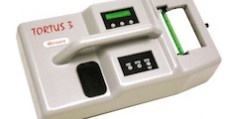
he instrument used is the Tortus II, built and designed by Wessex Test Equipment to meet international standards of ASTM, AASHTO, SHRP, EN and BS. Gets the dynamic friction coefficient measuring the force required to maintain a constant speed of a weight that pulls on the pavement.
Because of its portability, reliability of the results, as well as the requirements or pavement conditions necessary to perform the measurements are minimal, making this instrument is the ideal for testing in the vast majority of the pavement, both dry and wet.
The machine performs a programmed path on the pavement, drawing a graph with measurements of the device is obtenidas.La sole 4S type (standard, shoe sole, simulating) made in UK for Rubber and Plastics Research Association. Indications of the European Union indicate that the friction coefficient values below 0.4 are unsatisfactory, and values close to 0.2 are very dangerous. Areas with values
between 0.4 and 0.75 are considered good, and they get better results than 0.75 are considered safe (very good). The value of dynamic coefficient of friction of 0.4 is considered as the minimum required for pedestrian surfaces in the standard Australia and New Zealand. The differentiation between types of surfaces in the ISO standard has been located in the 0.4.
The test was carried out following the method described in the draft ISO / D1S 10545-17 Annex A “Ceramic Titles – Part 17 Determination Coeffient friction” which measure the coefficient of friction using a computer TORTUS on
surface, recording it during his tour, they oppose the force of a specimen slip rubber hardness standard IRHD 96 + -2, properties and dimensions specified above. TORTUS values are supplied by the friction coefficient expressed as the reluctance of the tiles to slip on the specimen surface, divided by the load on it.
The test is carried out first on a dry surface, and then on the same pre-moistened with a solution of distilled water and a wetting agent.
El ensayo se efectúa en primer lugar sobre la superficie seca, y a continuación ,sobre la misma previamente mojada con una solución de agua destilada y un agente mojante.

